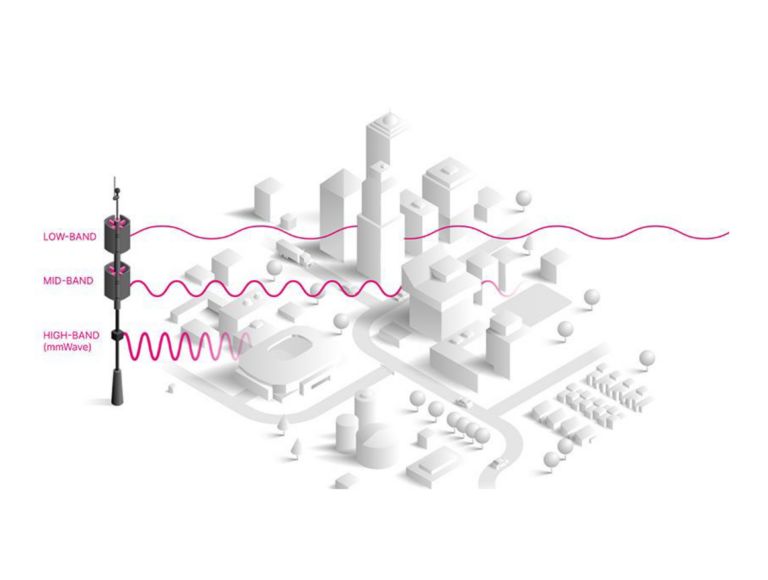
Let’s talk about spectrum: How more bands make a better network.
As businesses consider the fascinating use cases fueled by the 5G era, it’s helpful to understand how using multiple frequency bands—low-band, mid-band, and high-band—is a first step toward fulfilling the promise of a 5G-connected world. If you’re not a radio engineer, this territory can get confusing.
Before comparing the three band categories, there’s a key distinction to grasp. While high-band is attracting plenty of attention since it hasn’t been used for cellular before, don’t discount the conventional lower-frequency bands, which will carry much of the load. Here, we’ll explore the range of spectrum bands available and what this all means for unlocking business opportunities.
It’s all about bandwidth.
Achieving better upload and download speed depends on the bandwidth available to carry the mobile signal. 4G already has the capability to add together different frequency bands—even when they’re located in different parts of the spectrum—to increase the overall bandwidth and achieve higher data speed. Although developing 5G employs some smart technology to make more efficient use of the available spectrum to achieve more speed for the same bandwidth, like 4G it also leverages more parts of the spectrum that it can aggregate to boost speed even further.
5G adds the opportunity to carve up the spectrum so that each connected device gets just the bandwidth it needs, a concept called network slicing.
Fast data is just one promise of 5G, though: Ultralow latency and the potential to connect millions of devices, such as industrial sensors, are other key advantages with industry-transforming potential. As we’ll explain below, each band category has its own strengths. And with the potential of 5G, the ability to aggregate these attributes and bandwidth from multiple bands could in time provide whatever combination of speed, capacity, coverage, and low latency is required—even, if necessary, all at the same time.
This means that 5G is highly versatile—capable of supporting a variety of use cases with different requirements. For example, latency is not always important for industrial sensors, but for autonomous vehicles it’s critical. 5G adds the opportunity to carve up the spectrum so that each connected device gets just the bandwidth it needs, a concept called network slicing.
Below, we’ll dive deep to explore each band’s features and what this means for businesses and their future 5G goals.
Because low-band signals easily pass through buildings, they offer solid coverage indoors and outdoors and are an effective way to connect parts of rural America where even fixed broadband speeds don’t always meet national benchmarks.
Low-band.
Also known as the “coverage layer,” low-band 5G refers to frequencies below 1 GHz used to roll out substantial 5G coverage as quickly as possible. One example is the 600 MHz spectrum deployed by
A low-band cell site can cover hundreds of square miles and deliver a downlink data rate from 30-75 Mbps download—ideal for uses like streaming HD video. Because low-band signals easily pass through buildings, they offer solid coverage indoors and outdoors and are an effective way to connect parts of rural America where even fixed broadband speeds don’t always meet national benchmarks.
Low-band’s wide-area coverage offers potential to build out the base for the Industrial Internet of Things (IIoT) and to contribute to 5G innovations like supply chain logistics and smart agriculture.

Mid-band.
Operators are using mid-range frequencies (spanning 1 GHz and 6 GHz) to strike a balance between coverage and capacity. It’s expected that mid-band 5G could eventually form a major component of most 5G networks.
Mid-band 5G base stations can transmit and receive high-capacity signals over fairly large areas, and they can represent an ideal mix of performance for the bulk of 5G traffic in metropolitan areas.
Despite receiving plenty of publicity, high-band is actually a very specialized part of the 5G offering. Functioning over a shorter radius, it’s particularly useful in urban areas and busy venues like stadiums and shopping malls.
High-band (mmWave).
High-band 5G uses millimeter-wave (mmWave) frequency bands. Despite receiving plenty of publicity, high-band is actually a very specialized part of the 5G offering. Functioning over a shorter radius, it’s particularly useful in urban areas and busy venues like stadiums and shopping malls. High-band can simultaneously provide many high-speed connections focused on an area of just a block or two, from a small cell site mounted close to street level. The trade-off? High-band is more easily disrupted by things like buildings, glass, and foliage compared with lower bands. In some cases even this can be an advantage—for instance, keeping a factory 5G network confined to the relevant premises.
High-band 5G is already being deployed in some major cities. Today, download speeds for carriers’ high-band 5G can sometimes clock in around 450 Mbps, with peak speeds of nearly 1 Gbps, and upload speeds can near 50 Mbps.
Fueling the fourth industrial revolution.
These 5G frequency bands are key to 5G’s versatility and its potential success. The potential is clear: Enterprise customers have a new opportunity to boost productivity and efficiency as the 5G network continues to build out.
As enterprise companies race to optimize the fascinating promise of 5G, the ability to tap into different parts of the network to realize various use cases, leveraging the most appropriate 5G spectrum for each, could eventually drive adoption of the innovative business models they need to compete.